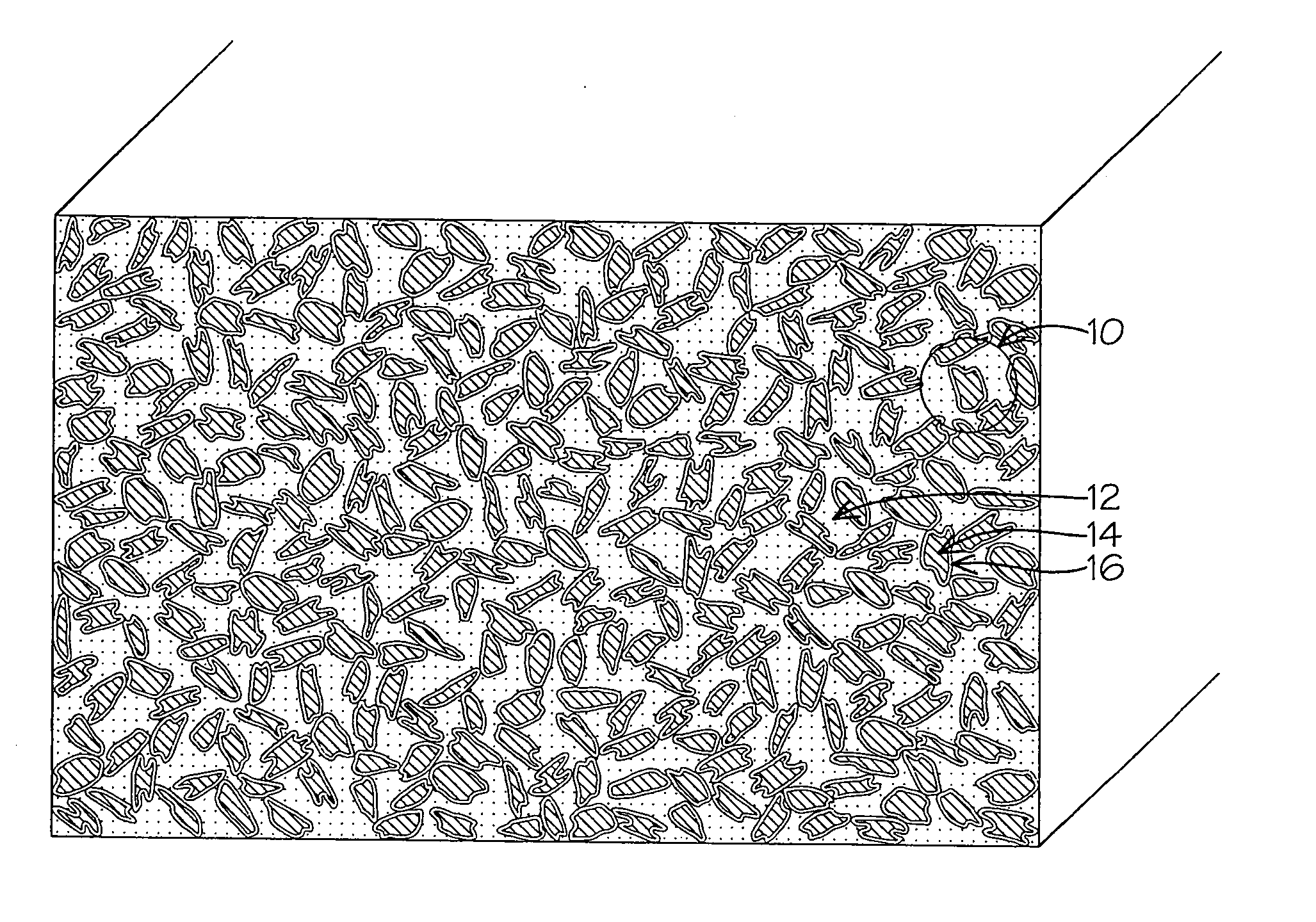Enhanced performance conductive filler and conductive polymers made therefrom
a technology of conductive polymers and fillers, which is applied in the direction of conductive materials, conductors, organic conductors, etc., can solve the problems of excessive cost of fillers and the perception of noble metals as too costly for some applications, and achieve the effect of enhancing physical and electrical properties
- Summary
- Abstract
- Description
- Claims
- Application Information
AI Technical Summary
Benefits of technology
Problems solved by technology
Method used
Image
Examples
example 1
[0042] Graphite powder of average particle size of 611 microns was clad by hydrometallurgy with nickel to produce a conductive powder 53% by weight nickel and 47% by weight graphite (true particle density 3.7g / cm3). As a comparison, conventional nickel coated graphite powder (Ni / Graphite) of composition 63.5% by weight Ni and 36.5% by weight graphite (true particle density 4.2 g / cm3) with an average particle size of 120 microns was used as baseline conductive powder filler. Conductive silicone rubber sheets were prepared as follows. Each powder sample was compounded with a heat curable silicone resin on a two-roll mill to 60% weight powder loading for the 611 micron powder and 63.5% by weight for the 120 micron powder. The different weight loading used for the two powders was to correct for differences in true particle density in order to prepare samples with an equal filler volume loading of about 31%.
[0043] The 120 micron nickel graphite powder required 35 minutes to fully incorp...
example 2
[0044] The silicone resin compound materials containing 120 micron particles and 611 micron particles as prepared in Example 1 were cured and molded in a hot press to form square conductive silicone rubber sheets 15 cm wide and 1.8 mm thick. The volume resistivities of the conductive cured sheets were measured on 1 cm diameter discs cut from the sheets through two electrodes connected to a 4-point resistance probe (Keithely™ model 580 micro-ohmmeter). The calculation of volume resistivity accounted for the volume of rubber between the two electrodes that was pressed on the opposite ends of each conductive silicone rubber disc.
[0045] The volume resistivity measured by this method was 25 mΩ·cm and 17 mΩ·cm for the 120 micron and 611 micron nickel graphite powders, respectively. This represents a 32% decrease in volume resistivity for the coarse powder compared to the finer powder as loaded in silicone rubber. The Shore A hardness of the disks was measured to be 79 and 77 for the120 m...
example 3
[0046] The discs prepared in Example 2 were placed into an air circulating oven set at 150 C for 48 hours. The disks were then remeasured for volume resistivity as reported in Table 1:
TABLE 1Volume resistivity and Shore A hardness for siliconerubber loaded with nickel graphite powders:VolumeVolumeVolumeNickelresistivity priorresistivityresistivityShore Agraphite typeto agingfollowing agingratiohardness120 micron25562.379611 micron17281.677
[0047] The sample with the 120 micron powder increased in volume resistivity by a factor of 2.3 (or 124% increase), while sample with the coarser sample only increased by a factor of 1.6 (or 64% increase).
PUM
| Property | Measurement | Unit |
|---|---|---|
| size | aaaaa | aaaaa |
| size | aaaaa | aaaaa |
| size | aaaaa | aaaaa |
Abstract
Description
Claims
Application Information
 Login to View More
Login to View More - R&D
- Intellectual Property
- Life Sciences
- Materials
- Tech Scout
- Unparalleled Data Quality
- Higher Quality Content
- 60% Fewer Hallucinations
Browse by: Latest US Patents, China's latest patents, Technical Efficacy Thesaurus, Application Domain, Technology Topic, Popular Technical Reports.
© 2025 PatSnap. All rights reserved.Legal|Privacy policy|Modern Slavery Act Transparency Statement|Sitemap|About US| Contact US: help@patsnap.com


